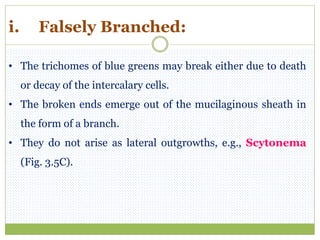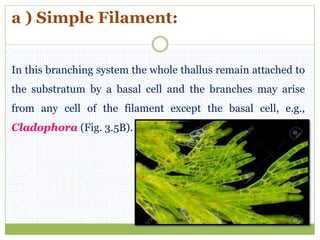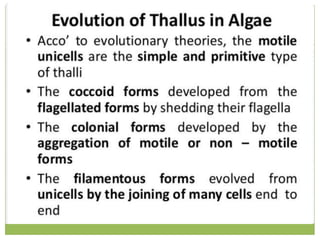Algae thallus
- 1. AISECT COLLEGE LIKE, COMMENT AND SHARE NOW Dr. Priya Trivedi M.Sc.(BOTANY), M.Ed., Ph.D.(Botany) Head , Academic and Department of Science at Compfeeders Aisect College of Professional Studies, Indore
- 2. Welcome to the Kingdom of Algae..... ALGAE Thallus Organization
- 3. Thallus Organization in Algae: • Thalli of algae show a range of organization starting from unicellular form to highly organized multicellular habit where the plant body is differentiated into root-like, stem-like, and leaf like structures giving a higher plant-like appearance. • Their size ranges from a few micron to several meters.
- 5. The algal thalli are grouped into the following, based on their organization: A.Unicellular Algae: Unicellular forms of algae are also called acellular algae as they function as complete living organisms. Unicellular forms are common in all the groups of algae except Rhodophyceae, Phaeophyceae and Charophyceae. The unicells may be motile or non-motile.
- 6. The motile unicells are either rhizopodial or flagellated. The rhizopodial forms lack rigid cell wall and have cytoplasmic projections that help them in amoeboid movement, e.g., Chrysamoeba (Chrysophyceae, Fig. 3.1 A), Rhizochloris (Xantho- phyceae).
- 7. The flagellated unicells resemble the motile gametes and zoospores. The flagella function as the organ of locomotion varying in number and type in different groups. The flagellated unicells are found in many groups of algae, e.g., Phacotus (Fig. 3.1 B) and Chlamydomonas (Fig. 3.1 C), of Chlorophyceae. Euglena of Eugleno- phyceae etc.
- 8. b. The non-motile cells may be spiral filament as found in Spirulina (Cyanophyceae) (Fig. 3.2A). The coccoid unicellular algae are the simplest forms of algae found in Cyanophyceae, Chlorophyceae etc., e.g., Gloeocapsa, Chlorella (Fig. 3.2B).
- 10. B. Multicellular Algae: 1. Colonial: The colonial habit is achieved by loose aggregation of cells within a common mucilaginous investment. The cells of these usually remain connected with each other by cytoplasmic threads. a. Coenohium: When a colony has a definite number of cells with a definite shape and arrangement, it is called coenobium. Coenobium may be: i. Motile, or ii. Non- motile.
- 11. i.) In motile form, cells are flagellated and whole coenobium can move by the organised beating action of flagella e.g., Volvox (Fig. 3.3A), Pandorina (Fig. 3.3B), Eudorina etc. In Volvox the coenobium is a hollow sphere.
- 12. Volvox Pandorina
- 13. ii.) In non-motile form, the cells are without flagella, thereby the coenobium is non- motile, e.g., Scenedesmus (Fig. 3.3C), Hydro- dictyon (Fig. 3.3D). Scenedesmus Hydro- dictyon
- 14. b. Aggregated Form: Unlike coenobium the cells are aggregated irregularly showing a colonial mass of various size and shape. It is of three types: i. Palmelloid ii. Dendroid and iii. Rhizopodial.
- 15. i. Palmelloid: • In this type the non- motile cells remain embedded in an amorphous gelatinous or mucilaginous matrix. • Each and every cell of the organisation is independent and can perform all the functions as an individual. Chlamydomonas and Chromulina represent palmelloid as a temporary feature in their life cycle. • But in Tetraspora (Fig. 3.4A, B) and Palmodictyon (Chlorophyceae), Gleochloris and Chlorosaccus (Xanthophyceae), Phaeocystis (Chrysophyceae) and Microcystis (Cyanophyceae), the palmelloid habit is a permanent feature.
- 17. ii. Dendroid: • In this type the number, shape and size of the cell is variable. • They look like microscopic trees (e.g., Prasinocladus, Ecballocystis, Chrysodendron ) • A mucilaginous thread is present at the base of each cell, thus showing a sort of polarity.
- 18. iii. Rhizopodial: In this type the cells are united through rhizopodia. e.g., Chrysidiastrum (Chrysophyceae). Chrysidiastrum
- 19. 2. Filamentous: The filamentous plant body is formed through repeated cell divisions in a single plane and in a single direction, where the cells remain firmly attached to each other — end to end forming a chain or a thread. The filaments may be unbranched or branched.
- 20. a. Unbranched Filament: • It may be free-floating (e.g., Spirogyra, Fig. 3.5A) or attached to the substratum (e.g., Ulothrix, Oedogonium etc.). • The free-floating unbranched filaments are not differentiated into basal and apical ends. All the cells in the filament are alike. • But the Unbranched filaments that remain attached to the substratum are differentiated into base and apex. • All the cells of the filament are similar except the basal attachment cell that is specially modified for the purpose called holdfast or rhizoidal cell. • The cell is devoid of chloroplast and only performs the function of anchorage. So certain degree of division of labour among the cells of the filament is established as rest of the cells performs photosynthetic and reproductive functions.
- 21. b. Branched Filament: It is formed when a filament occasionally starts division in a second plane. It is of two types: i. Falsely branched, and ii. Truly branched.
- 22. i. Falsely Branched: • The trichomes of blue greens may break either due to death or decay of the intercalary cells. • The broken ends emerge out of the mucilaginous sheath in the form of a branch. • They do not arise as lateral outgrowths, e.g., Scytonema (Fig. 3.5C).
- 24. ii. Truly Branched: When a cell in the filament occasionally starts division in a second plane, true branch is formed. Thus true branches arise as lateral outgrowths of the main filament. True branches are of the following three types: i) Simple filament, ii) Heterotrichous habit, and iii) Pseudoparenchymatous habit.
- 25. a ) Simple Filament: In this branching system the whole thallus remain attached to the substratum by a basal cell and the branches may arise from any cell of the filament except the basal cell, e.g., Cladophora (Fig. 3.5B).
- 26. b) Heterotrichous Habit: In this branching system the whole thallus is differentiated into prostrate and erect system. Both the prostrate and erect systems may be well-developed (e.g., Fritschiella, Ectocarpus, Fig. 3.6A). Progressive elimination of the prostrate system is observed in Draparnaldiopsis (Fig. 3.6B), Stigoclonium, of the erect system as in Coleochaete (Fig. 3.6C).
- 28. C ) Pseudoparenchymatous Habit: If one or more central or axial filaments together with their branches fuse to form a parenchymatous structure, it is called pseudoparenchymatous thallus. Again, if it is formed by the branches of a single filament it is known as uniaxial (e.g., Batrachospermum, Fig. 3.7A, B), or it may be multiaxial where more than one filament are involved (e.g., Polysiphonia, Fig. 3.7C)
- 30. 3. Siphonaceous Forms: In this form the thallus is aseptate and multinucleate i.e., a coenocyte. It may be simple branched (e.g., Vaucheria, Fig. 3.8A) or may be very elaborate with clear division of labour, differentiated into aerial and subterranean portions (e.g., Botrydium, Fig. 3.8B).
- 32. 4. Parenchymatous Forms: When the cells of a filament divide in multidirectional planes, it results the formation of a parenchymatous thallus and ultimately becoming foliose and flat (e.g., Ulva, Fig. 3.9A), tubular (e.g., Enteromorpha, Scytosiphon) or complex (e.g., Sargassum, Fig. 3.9B) structure.
- 37. YOU CAN GO THROUGH OUR WEBSITES www.aisectcollegeindore.com , aisectcollege123@gmail.com , madhuban123@gmail.com THANKS FOR WATCHING OUR VIDEO





































